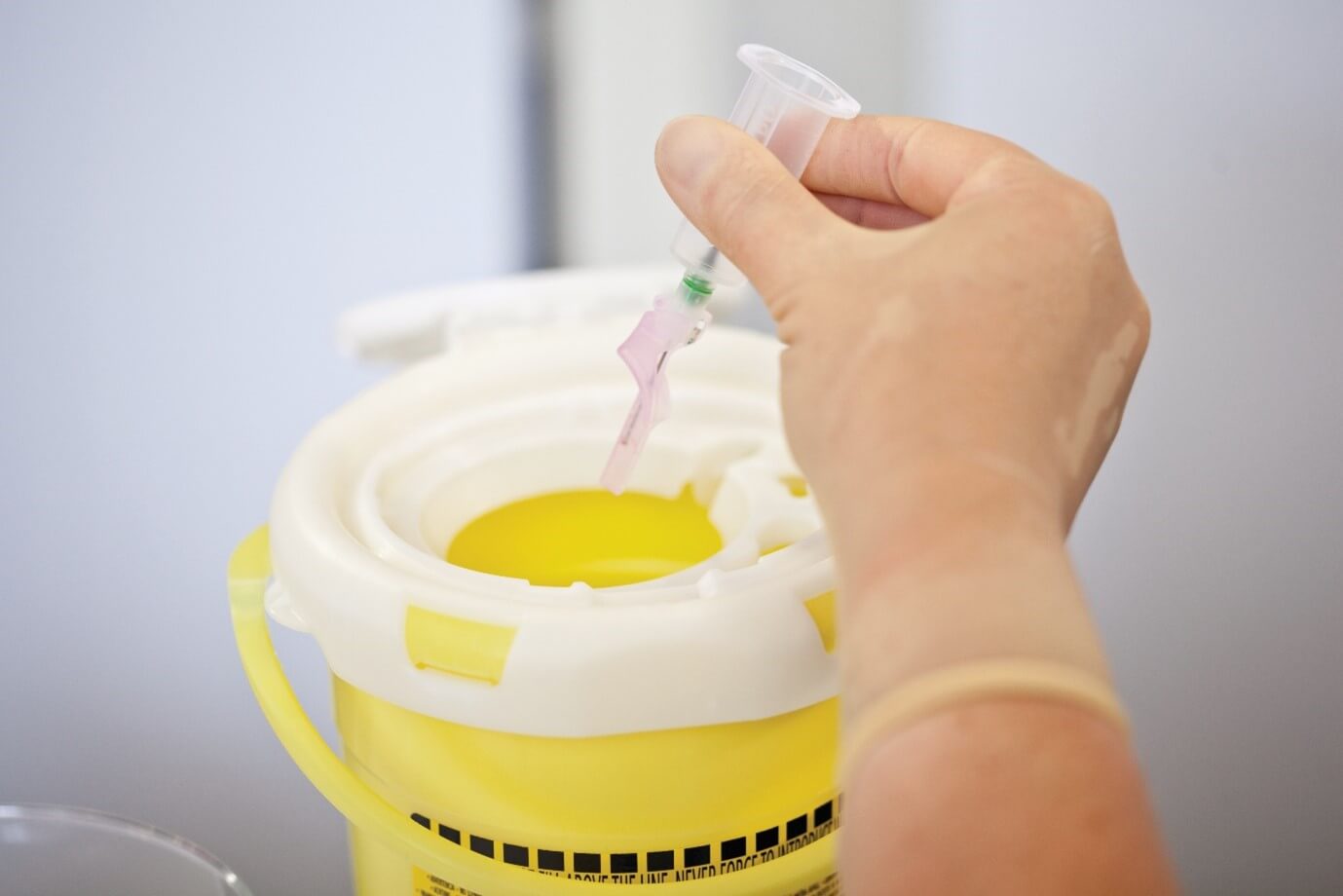European Biosafety Network webinar on preventing sharps injuries, Medical Device Regulation and safety mechanisms in medical devices
Sharps injuries have been around since the beginning of medicine, so they are by no means a new issue for the medical community. However, it remains an ongoing problem and therefore continues to be a topic for conversation. Medical sharps, which can transmit bloodborne diseases1, pose a significant safety risk to healthcare workers. Though it is not a new topic in healthcare worker safety, there are still many unaddressed risks that could result in a sharps injury.
On June 15, 2021, the European Biosafety Network (EBN) hosted a seven-part webinar with regional experts presenting the latest insights into sharps injury prevention and the current challenges facing the medical industry. Key topics included updates on Medical Device Regulation (MDR) and the use of safety mechanisms in medical devices.
How have policymakers shaped sharps injury management?
Simone Mohrs, policy officer at the European Hospital and Healthcare Employers’ Association (HOSPEEM) and Adam Rogalewski, policy officer for health and social services at the European Federation of Public Service Unions (EPSU), presented new survey results that reviewed the progress on the implementation of the EU Sharps Directive 2010/32/EU. The directive set out to provide stricter sharps injury prevention measures, including policies in risk assessment, prevention and monitoring.2 The survey showed that implementing these measures at a grassroots level was successful, yet there are still gaps in a greater, comprehensive prevention strategy.3
Former Senior Inspector at the Dutch Healthcare Inspectorate, Infection Control Practitioner and Epidemiologist at the Amsterdam University Medical Centre, Paul van Wijk, presented the approach taken in the Netherlands. There are an estimated 13,000-16,000 blood exposure accidents in the Netherlands every year but thanks to vaccination requirements among healthcare workers, there are low rates of hepatitis B virus (HBV), hepatitis C virus (HCV) and human immunodeficiency viruses (HIV).3 However, despite this successful vaccination program, the implementation of the Sharps Directive 2010/32/EU is still ongoing.3
The Vice Secretary General of the Spanish General Council of Nursing (SGCN), Jose Luis Cobos Serrano, confirmed that the Netherlands are not alone in this. The SGCN undertook a study to check the compliance of the Sharps Directive 2010/32/EU and implementation of safety measures in Spanish healthcare facilities. The study, which gathered data from 71 hospitals and 73 healthcare centres, found that the directive was not implemented in all Spanish facilities.3 Despite 95% of Spanish healthcare facilities experiencing sharps injuries during the study, risk assessments were not carried out in 9.7% of the facilities examined.3
Why is sharps injury prevention still a challenge?
The COVID-19 pandemic has had an impact on the entirety of the healthcare system, including the prevention of sharps injuries. Ian Lindsley, secretary of EBN, presented the findings of an Ipsos MORI survey on the scope of sharps injuries before and after the pandemic. Before the pandemic, there was an estimated 1.2 million sharps injuries each year in Europe,3 but the number could be 10 times higher due to under-reporting.4 The survey found that the additional pressure on healthcare workers due to the COVID-19 pandemic has likely increased the number of sharps injuries by an estimated 276,000.3 Despite the integration of the directive in Dutch occupational law, there continues to be a variety of reasons that make the implementation of the directive difficult. In the Netherlands, the lack of safe alternatives for all current sharp devices has proved to be an obstacle in sharps injury prevention. It is especially difficult to access and implement safety sharps for home healthcare providers and smaller Dutch organisations, van Wijk mentioned. Because of this, the challenge of sharps injury prevention in the Netherlands is still ongoing.3
In Spain, distribution is also an obstacle. Though Spanish hospitals are well-equipped with safety sharps, Cobos Serrano stated that their healthcare centres were still lacking stronger safety measures. Also, Spanish healthcare workers are yet to be fully trained on the use of these devices. Serrano commented that 18.8% of Spanish healthcare staff were not trained to use a medical device with a safety mechanism.3 Another challenge Cobos Serrano presented was the discrepancy between the safety of the devices themselves. Blood collection and catheter devices were more likely to have safety mechanisms than pre-filled syringes, scalpels and insulin pens.3
What is being done to address the existing challenges?
The goal of Medical Device Regulation (MDR) is to ensure a high level of protection for patients and users, and it sets high standards of quality and safety for medical devices in order to meet common safety concerns as regards such products. Francoise Schlemmer, director of the European Association for Medical Devices of Notified Bodies (Team NB), discussed their approach to the implementation of MDR after May 2021 to address these existing challenges. With the goal of preventing sharps injuries, Team NB focuses on surveying and reviewing devices, promoting technical and ethical standards and participating in improving the legal framework. Team NB also proposes a new standard on safety mechanisms in medical devices to prevent sharps injuries.3
Policy and Legal Officer at the European Commission, Mario Gabrielli-Cossellu, aims to focus on the standardisation request for MDR and the new harmonised European standards, including sharps injury protection and interpretation of points 11.1 and 22.2 of Annex I of the MDR. They state that devices must be designed to eliminate or reduce as much as possible the risk of infections and that they must be designed to be safely and accurately used by the intended user at all stages of the procedure.5 To that end, an observatory is being developed by the Directorate-General for Health and Food Safety (DG SANTE) to collect more sharps information from member states, EPSU and HOSPEEM as well as working alongside the EBN to ensure the implementation of the sharps directive.3
Aside from policy action, a wider adoption of safety sharps devices could help in the prevention of sharps injuries. Cobos Serrano noted that in Spain, safety devices were the best way to protect their healthcare workers from sharps injuries.3 Laurence Bouret, CEO of DASTRI, a coalition of French healthcare organisations focusing on sharps risk prevention, discussed sharps protection features for single-use hypodermic needles and introducers for catheters and needles used for blood sampling. DASTRI is seeking to ensure the inclusion of all sharps devices across their entire life cycle in medical waste management systems.3
Despite the challenges that sharps injuries pose, the ongoing work to reduce the problem proves the future could bring about the change required in the field. The implementation of directives and further development of safety mechanisms could help make sharps injuries a concept of the past. To learn directly from the experts about sharps injuries, MDR and safety mechanism in medical devices in more detail, read the notes from the EBN webinar.
#bloodbornedisease #catheter #EBN #EuropeanBiosafetyNetwork #healthcareworkersafety #infection #infectionprevention #MDR #MedicalDeviceRegulation #Medicalsharps #needle #sharps #sharpsinjuries #webinar
References
- Lauer AC, Reddemann A, Meier-Wronski CP, Arendt M, Peters H, Gross M. Needlestick and sharps injuries among medical undergraduate students. American Journal of Infection Control. 2014(42)3:235-239. doi.org/10.1016/j.ajic.2013.08.013
- European Agency for Safety and Health at Work. Directive 2010/32/EU: prevention from sharp injuries in the hospital and healthcare sector. Published on June 18, 2021. Accessed on July 27, 2021 at https://osha.europa.eu/en/legislation/directives/council-directive-2010-32-eu-prevention-from-sharp-injuries-in-the-hospital-and-healthcare-sector
- European Biosafety Network. EBN webinar on preventing sharps injuries, MDR and safety mechanism in medical devices. Published on June 15, 2021. Accessed on July 27, 2021 at https://www.europeanbiosafetynetwork.eu/wp-content/uploads/2021/06/Sharps-webinar-notes-15.06.2021.pdf
- Elder A, Paterson C. Sharps injuries in UK health care: a review of injury rates, viral transmission and potential efficacy of safety devices. Occupational Medicine. 2006(56)8:566-574. https://doi.org/10.1093/occmed/kql122
- Medical Device Regulation. ANNEX I: General safety and performance requirements. Published on July 23, 2019. Accessed on August 6, 2021, at https://www.medical-device-regulation.eu/2019/07/23/annex-i-general-safety-and-performance-requirements/
Approval number: BD-42850.




